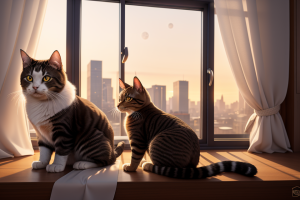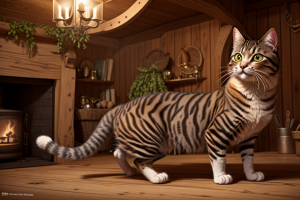What Does It Mean When a Cat Appears in Art?

When a cat appears in art, it can symbolize many things. It could represent independence, mystery, or even the supernatural. Cats have been featured in art for centuries, from ancient Egyptian paintings to modern pop art. In this article, we will explore the various meanings and interpretations of cats in art, and how they have been used to convey different messages throughout history. Whether you are a cat lover or simply appreciate the power of art, this article will provide a fascinating look into the world of feline-inspired creativity. So, let’s dive in and discover what it means when a cat appears in art.
When a cat appears in art, it can symbolize many different things depending on the context of the artwork and the culture it originates from. In some cultures, cats are seen as symbols of good luck and prosperity, while in others they are associated with mystery and magic. Cats have also been depicted in art as a representation of grace and beauty, as well as a source of inspiration for artists. Ultimately, the meaning of a cat’s appearance in art is subjective and open to interpretation.
The Historical Significance of Cats in Art
The Role of Cats in Ancient Civilizations
Cat Worship in Ancient Egypt
In ancient Egypt, cats were highly revered and worshiped as sacred animals. The cult of Bastet, the goddess of fertility, protection, and cats, played a significant role in the veneration of felines. Bastet was often depicted with the head of a cat or a lioness, embodying both the gentle and fierce aspects of the feline spirit.
The Symbolism of Cats in Funerary Rites
Cats held immense symbolic value in funerary rites and the afterlife. They were believed to protect the soul of the deceased on their journey to the afterlife, as well as guard the tombs against malevolent spirits. As a result, many ancient Egyptian tombs contained images of cats or statues of Bastet to ensure the safe passage of the soul into the afterlife.
Cat Imagery in Greco-Roman Art
The imagery of cats in Greco-Roman art often portrayed them as symbols of fertility, beauty, and grace. Cats were also associated with women, who were considered their protectors and companions. The goddess Diana, for example, was frequently depicted with a cat by her side, symbolizing her connection to nature and the feminine aspects of life.
The Connection Between Cats and Women
The association between cats and women was rooted in the practical aspects of their coexistence. Women were responsible for managing the household, which included caring for the family’s cats. This close relationship between women and cats was further emphasized by the cats’ ability to produce milk, which was seen as a nourishing and life-giving substance.
The Symbolism of Cats in Mythology
In Greek mythology, cats were often linked to the story of the goddess Hera and the legend of the lion-skin. Hera, the queen of the gods, was said to have a magical lion-skin that granted her immense power and authority. When she wore the skin, she transformed into a powerful lioness, symbolizing her strength and dominance. Cats, with their association with both the gentle and fierce aspects of the feline spirit, were seen as embodiments of this dual nature.
Cat Imagery in the Renaissance Period
The Depiction of Cats in the Works of Leonardo da Vinci and Michelangelo
The Role of Cats in Leonardo da Vinci’s “The Lady with an Ermine”
Leonardo da Vinci’s “The Lady with an Ermine” is a painting that features a woman holding a small ermine, which is a type of weasel, in her arms. The ermine is depicted with a curious and lively demeanor, while the woman is portrayed with a calm and composed expression. The presence of the cat in the painting serves to add a sense of naturalism and realism to the scene, as well as to symbolize the woman’s grace and beauty.
The Use of Cat Imagery in Michelangelo’s “The Madonna and Child”
Michelangelo’s “The Madonna and Child” is a sculpture that depicts the Virgin Mary holding the infant Jesus. In this work, Michelangelo includes a small cat that is positioned at the base of the sculpture. The cat is depicted with its head turned to the side, and its tail wrapped around its body. The inclusion of the cat in the sculpture serves to add a sense of naturalism and realism to the scene, as well as to symbolize the maternal love and protection of Mary towards Jesus.
The Surrealist Movement and Feline Imagery
The Obsession with Cats Among Surrealist Artists
The surrealist movement, which emerged in the early 20th century, was characterized by its exploration of the unconscious mind and the use of dreamlike imagery. One of the most prevalent motifs in surrealist art was the cat, which became a symbol of the unconscious and the unknown.
The Influence of Catalan Mythology on Surrealist Art
The surrealists were heavily influenced by Catalan mythology, which featured the cat as a symbol of mystery and magic. The legend of the “Catalan leopard,” a creature that was said to be half-lion, half-cat, captured the imagination of the surrealists and inspired many of their works.
The Use of Cats as Symbols of the Unconscious Mind
The cat’s ability to appear both fierce and graceful, wild and domesticated, made it an ideal symbol of the unconscious mind. Surrealist artists such as Salvador Dali and Rene Magritte used cats in their paintings to represent the unseen forces that shape our dreams and desires.
In Dali’s famous painting “The Persistence of Memory,” for example, a melting clock is accompanied by a small cat, which seems to be staring into the depths of the painting. This cat represents the viewer’s own consciousness, peering into the mysterious world of the unconscious.
Similarly, in Magritte’s “The Son of Man,” a man in a bowler hat is seen floating in the sky, while a calm and seemingly unfazed cat sits on a red brick wall below. The cat represents the viewer’s own internal world, a world that is both familiar and strange, known and unknown.
Overall, the surrealists’ obsession with cats was a reflection of their fascination with the unconscious mind and the mysteries of the human psyche. By using cats as symbols of the unknown, they were able to explore the depths of the human psyche in their art, creating works that continue to captivate and intrigue viewers today.
The Significance of Cats in Contemporary Art
The Use of Cats in Street Art and Graffiti
The Role of Cats in the Works of Banksy and Shepard Fairey
Cats have been a recurring motif in the works of prominent street artists such as Banksy and Shepard Fairey. Banksy, the anonymous British street artist, has incorporated cats in several of his works, often with humorous or satirical undertones. In one of his famous pieces, Banksy depicted a group of rats wearing suits and carrying briefcases, with one rat sporting a top hat and monocle, while another was smoking a cigar. In the background of the image, a cat could be seen casually observing the scene.
Similarly, Shepard Fairey, the American street artist known for his “Obey” street art campaign, has also featured cats in some of his works. In his “Harmony Project” series, Fairey incorporated images of cats along with other animals, creating a sense of unity and harmony among different species.
The Politics of Cat Imagery in Street Art
The use of cats in street art and graffiti often carries political undertones. In some cases, cats are used as a metaphor for resistance against oppressive systems. For instance, a street artist known as “Cake” created a mural in Berlin that featured a cat wearing a gas mask, symbolizing resistance against environmental pollution and political oppression.
On the other hand, some street artists use cat imagery to critique consumer culture and capitalism. In a series of paintings, the street artist “Miss Van” depicted cats as fashionable and materialistic creatures, lampooning the superficiality of contemporary society.
Overall, the use of cats in street art and graffiti serves as a powerful tool for artists to convey their political messages and comment on social issues. By incorporating cats into their works, artists can engage with their audience in a playful and accessible way, while also delivering a powerful punch.
The Influence of Internet Culture on Cat Art
The Rise of “Cute” Cat Art
In recent years, the internet has played a significant role in shaping the way we perceive and engage with cat art. One notable trend is the rise of “cute” cat art, which has become increasingly popular on social media platforms and online marketplaces. This type of art often features cute, cartoon-like depictions of cats, with exaggerated features such as oversized eyes and a round, chubby body.
The proliferation of “cute” cat art can be attributed to the widespread appeal of cute and cuddly creatures, which has been a recurring theme in popular culture for decades. The internet has only amplified this trend, with social media platforms like Instagram and Twitter providing a platform for artists to share their work with a global audience. As a result, the demand for “cute” cat art has soared, with many artists capitalizing on this trend by creating prints, plush toys, and other merchandise featuring their beloved feline characters.
Another factor contributing to the rise of “cute” cat art is the way it taps into our emotions, providing a much-needed escape from the stresses of daily life. Cats have long been associated with comfort and relaxation, and the “cute” cat art trend capitalizes on this association, offering viewers a chance to connect with these furry creatures on an emotional level. By creating art that is both adorable and relatable, artists are able to connect with their audience on a deeper level, fostering a sense of community and shared experience.
In addition to its emotional appeal, “cute” cat art has also become a popular form of self-expression for many artists. By creating their own unique feline characters, artists are able to explore their own creativity and share their work with others. This has led to a thriving online community of cat artists, who share their work, offer feedback, and collaborate on new projects. As a result, the influence of internet culture on cat art has had a profound impact on the way we perceive and engage with this beloved animal.
The Psychology Behind Our Fascination with Cats in Art
The Connection Between Cats and Human Emotions
The Calming Effect of Cat Imagery
Cats have been a popular subject in art for centuries, and their appeal is not limited to the art world alone. They have become a staple in various forms of media, from books to films, and have captured the hearts of millions of people worldwide. One of the main reasons behind this fascination is the calming effect that cat imagery has on the human mind. The gentle movements, the soft fur, and the playful behavior of cats all contribute to a sense of serenity and relaxation that many people find irresistible. This is why cats are often used in advertising campaigns for products that promote relaxation and stress relief, such as calming teas or aromatherapy candles.
The Connection Between Cats and Nurturing Emotions
Another reason why cats are so popular in art is their ability to evoke nurturing emotions in humans. This connection is rooted in our evolutionary history, as cats were once our hunting partners and protectors. They were instrumental in ensuring our survival, and in return, they earned a special place in our hearts. This relationship is reflected in the way we portray cats in art, often depicting them as affectionate and loyal companions. They are frequently shown curled up next to their human counterparts, or sitting on their laps, symbolizing a deep sense of trust and intimacy. By depicting cats in this way, artists are tapping into our primal desire for companionship and nurturing, creating a sense of warmth and comfort that resonates with us on a deep emotional level.
The Symbolic Significance of Cats in Art
The Cat as a Symbol of Independence and Freedom
Cats have long been associated with independence and freedom. In ancient Egypt, cats were revered for their ability to hunt and protect the household from vermin. This led to them being seen as symbols of protection and freedom.
In art, cats are often depicted as solitary figures, roaming freely through landscapes or perched atop high places. This reflects the cat’s reputation for being independent and self-sufficient animals, capable of adapting to a wide range of environments.
Additionally, the cat’s agility and stealth have made them a popular symbol in literature and folklore. For example, in the story of “Puss in Boots,” the cat uses his cunning and agility to help his master rise from poverty to wealth. This story reinforces the idea of the cat as a symbol of independence and resourcefulness.
The Cat as a Symbol of Seduction and Mystery
Cats have also been associated with seduction and mystery. This can be traced back to ancient Egypt, where cats were linked to the goddess Bastet, who was associated with fertility and love. In art, cats are often depicted as sensual and alluring creatures, with flowing lines and expressive eyes.
This association with seduction and mystery has continued throughout history, with cats often appearing in paintings and literature as symbols of temptation and intrigue. For example, in the story of “The Lady and the Cat,” a cat uses her charm and wit to manipulate a woman into giving her food and attention. This story reinforces the idea of the cat as a symbol of seduction and mystery.
Overall, the symbolic significance of cats in art reflects our fascination with their independence, freedom, seduction, and mystery. Whether depicted as solitary hunters or alluring seductresses, cats have captured our imagination for centuries, and continue to be a popular subject in art and literature today.
FAQs
1. What is the significance of a cat appearing in art?
A cat appearing in art can symbolize a variety of things depending on the context of the artwork and the culture it originates from. In some cultures, cats are seen as symbols of good luck, while in others they are associated with bad luck or even evil. Additionally, cats have been used in art as a way to convey certain emotions or themes, such as mystery, independence, or even sexuality.
2. What is the history of cats in art?
Cats have been depicted in art for thousands of years, with evidence of cat paintings and sculptures dating back to ancient civilizations such as Egypt, Greece, and Rome. In Egyptian art, cats were often depicted as sacred animals associated with the goddess Bastet, while in Greek and Roman art, they were often shown as symbols of playfulness and curiosity. Over time, cats continued to be depicted in art throughout the world, often appearing in paintings, sculptures, and other forms of visual art.
3. What is the cultural significance of cats in different regions?
The cultural significance of cats varies greatly depending on the region and the specific culture. For example, in ancient Egypt, cats were highly revered and seen as sacred animals, while in medieval Europe, they were often associated with witchcraft and evil. In Japan, cats are considered to be good luck charms, while in some parts of Africa, they are believed to possess healing powers. The way cats are depicted in art can reflect these cultural beliefs and attitudes towards cats.
4. How has the portrayal of cats in art changed over time?
The portrayal of cats in art has changed significantly over time, reflecting changing attitudes towards cats and evolving cultural beliefs. For example, in medieval art, cats were often depicted as mischievous and evil, while in Renaissance art, they were shown as more docile and domesticated. In modern art, cats are often depicted in a more realistic and naturalistic style, with an emphasis on their physical characteristics and behavior. Additionally, the rise of internet culture and social media has led to a new wave of cat-themed art, with many artists using cats as a way to express themselves and connect with audiences.








